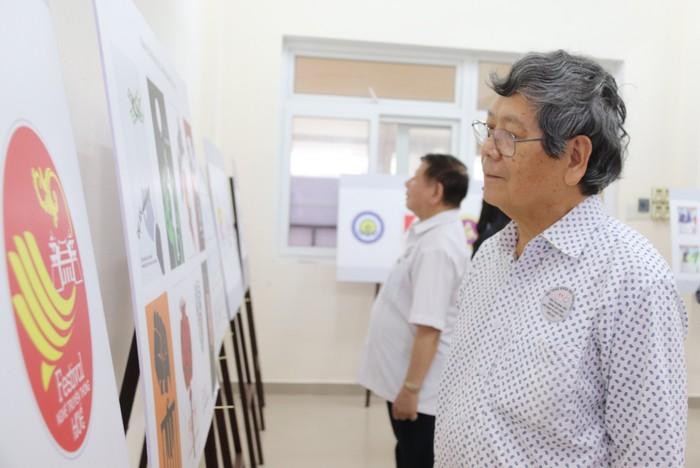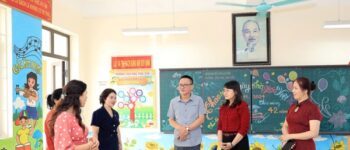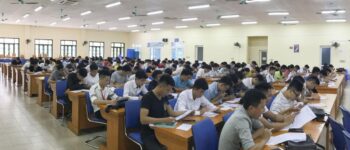Autonomy is an attribute of higher education, a natural thing for international higher education, but it is a challenging issue in Vietnam with many problems. Therefore, experts and universities all believe that it is necessary to create a synchronous legal corridor to be able to implement autonomy in depth, without problems.
- Tin học, Công nghệ quan trọng với nhân lực STEM, cần đưa vào tổ hợp xét tuyển ĐH
- 70% thời gian đào tạo thực hành: SV ngành Công nghệ Kỹ thuật Ô tô có lợi thế lớn
- Tìm hiểu về thị trường giao dịch hàng hoá phái sinh
- Đóng tiền triệu lắp điều hòa, 1 số phụ huynh THPT Nguyễn Thị Minh Khai ý kiến
- Tác động của Luật Thủ đô đến các trường đại học, cao đẳng
Faced with that reality, reporters from the Vietnam Education Electronic Magazine had an interview with Dr. Vu Ngoc Hoang – Chairman of the Association of Vietnamese Universities and Colleges to hear his views on this issue.
Bạn đang xem: TS.Vũ Ngọc Hoàng nêu 10 việc cần làm ngay nếu xây dựng Nghị quyết riêng về GDĐH
Reporter: Dr. Vu Ngoc Hoang, how do you view university education since Resolution 29-NQ/TW?
Dr. Vu Ngoc Hoang: Resolution No. 29-NQ/TW of the Central Executive Committee on fundamental and comprehensive innovation in education and training was issued more than 10 years ago. It is a very important Resolution, with many good contents on innovation, very necessary, progressive and in the right direction.
In the recent Conclusion No. 91-KL/TW of the Politburo on continuing to implement Resolution 29 of the 11th Party Central Committee, the results achieved by higher education after 10 years of implementing Resolution 29 were stated, so I will not list the achievements again.

Dr. Vu Ngoc Hoang – President of the Association of Vietnamese Universities and Colleges (photo: Moc Tra)
After more than 10 years of implementing Resolution 29 of the Central Committee, I see:
Improving the quality of education is the biggest and most consistent requirement in the spirit of Resolution 29, but looking back now, it is still unclear how we have improved it. There are even many things and many problems that go against that spirit (such as lowering standards to increase quantity to increase revenue, the disease of achievement, negative cheating in management, school ethics and of some officials in the industry, some teachers are degraded, etc.).
Quality is one of the first characteristics of education. Education is aimed at improving the quality of people. Education is for the quality of a community, of a nation. Even mass education is aimed at improving the quality of the community. Many issues about quantity are also about quality (for example, the rate of people going to school, having received training, etc.).

The issue of quantity in education is also for the quality of the community, it must be linked to quality. Without quality, education is no longer education and is even no longer useful. The first and foremost goal of educational innovation is to improve the quality of educational activities. Since the Resolution, what have we done to ensure and improve quality? We need to look back clearly and find specific solutions to meet the requirement of improving the quality of the entire education system of our country.
State investment in education, especially higher education, is very limited. There is no clear distinction between socialization, privatization and commercialization of education. Socialization and privatization are quite different, although they both have the effect of limiting state-levelization. Socialization leads to the formation of social ownership, while privatization leads to the formation of private ownership. Private ownership is also good and encouraged, especially in conditions where state capital and community capital are limited.
But on the other hand, it must be seen that educational activities are highly social, so they are very suitable for social ownership. We have had a series of private schools in the higher education sector, where social ownership (of the school community) had been formed, but they were suddenly divided into private schools to become private schools with profit sharing, thereby transforming educational activities from being largely non-profit (the undivided accumulated fund in many places has accounted for over 70% – up to 90%) into profit-making activities and profit sharing for individuals, even the very large undivided fund is no longer represented for management but is all handed over to private management and use. The Association of Vietnamese Universities and Colleges has proposed to resolve this situation, but so far no competent authorities have resolved it. It is unclear what is the problem that is so difficult to resolve?
Most of the workforce has not received technical training (75%) or has received substandard training (in terms of expertise).
Unreasonable human resource structure (type, level) makes the average labor productivity of Vietnamese workers many times lower than that of the world and the region.
Xem thêm : Huyện Phúc Thọ: Gắn biển công trình Trường THCS Long Xuyên
Training activity planning is not closely following the socio-economic development strategy of the country and locality;
There is almost no differentiation of learners and educational institutions. The national education system is fragmented and unsystematic. The interconnection mechanism is unclear and unfeasible.
Overlapping management mechanisms, many focal points, ineffective.
The type of non-profit school is developing in many developed countries, through the process of accumulation and donation, without forming private ownership, nor state ownership, it belongs to the school community, it will be a private school (not private as it is understood in Vietnam), it has been the policy of the Central Executive Committee of the Party for more than 10 years and is also in the law, but until now there has been no implementation guidance. The type of non-profit school is a very strategic solution to prevent and limit the very dangerous commercialization in education, it also contributes very importantly to ensuring the general safety of education in market economic conditions (like health insurance in protecting people's health)… but unfortunately it has not been implemented yet.
Reporter: From practical implementation, leaders of some universities have suggested that there should be a separate resolution on higher education after 10 years of implementing Resolution 29 on fundamental and comprehensive education reform. What is your opinion on this issue?
Dr. Vu Ngoc Hoang: I support this. That's great. There needs to be a separate resolution to promote innovation in higher education to solve current problems, creating conditions for higher education to truly play a key role in developing high-quality, highly-qualified human resources, associated with the development of science and technology, innovation in the country's socio-economic development. Since its inception, higher education has played a vital role in shaping world civilization and it has a decisive role in achieving or not becoming a developed industrialized country with a high income.
To have a good resolution on higher education, it is necessary to research and advise competent authorities on a number of issues regarding:
Unify the state management of the national education system. The state focuses on directing at the macro level and reasonably decentralizes to localities, ministries and branches.
Human resource training planning is linked to the process of economic restructuring of the whole country and each region. Building a strategy for developing higher education and vocational education that is sufficiently large and feasible to ensure enough high-quality human resources for the minimum requirements of a developed industrial country with high income in the next 20-25 years.
Promote the combined strength of the country and the entire education system, resolutely eliminate localism and separatism in each field, especially in the public education sector.
Educational programs need to focus on personality building and developing learners' abilities. Build an open education system, ensuring connectivity (between disciplines and levels of education).
Implement the streaming of students after high school. The State has policies to encourage streaming.
Standardize training levels: vocational high school, college, university (bachelor and engineer), master, doctorate.
Build lifelong learning habits, practical learning and practical work, linking degree training (initial training) with regular advanced training.
Continue to innovate the governance and management mechanism of higher education. Have a roadmap to eliminate the mechanism of the governing ministry (except for schools in the military and public security sectors). Grant real autonomy to higher education institutions with accountability. Focus on governance functions for the school council.
Promote socialization and prevent commercialization of education. The state budget focuses on lower levels of education and key targets. Especially encourage the development of non-profit non-public educational institutions. Implement the establishment of undivided accumulation funds at private schools to build the material foundation to ensure long-term survival conditions and limit the trend of commercialization.
Reporter: When drafting this Resolution, is it necessary to focus on university autonomy to review what overlaps and hinders and then amend it all at once to create conditions for university development, is that right, sir?
Xem thêm : Thế giới đang “khát” nhân lực tài năng những ngành công nghệ cao hơn bao giờ hết
Dr. Vu Ngoc Hoang: That is not the case, although university autonomy is a major focus. Without autonomy, it is impossible to mature because “children need constant guidance and supervision”. The problem here is that universities must be given much attention, developed with good quality, significantly more quantity than at present, implementing many synchronous solutions, ensuring the improvement of training and scientific research, especially meeting the cause of promoting industrialization in the new stage with the goal of becoming a developed industrial country with high income.
Reporter: From your personal perspective, if this Resolution is drafted, what is one of the things that needs to be done immediately?
Dr. Vu Ngoc Hoang: In my opinion, there are several urgent tasks that need to be implemented, including:
First, establish a general master plan for human resources and develop a university education plan for the first half of the 21st century.
Second, readjust the structure of the national education system, unify the state management at the ministerial level, and adhere to the criteria: Equity, Quality, Efficiency, Unity, and Internationalization. Transfer vocational colleges back to university education (level 5 ISCED-2011) to train senior technicians together with applied universities. Amend the Law on Vocational Education to Vocational Education at 3 levels: elementary, intermediate, and advanced vocational, with a system of worker ranks.

Third, stream students after junior high school in two directions: High school and Career-oriented High School/Vocational High School (ensuring that graduates have both high school education and a skilled job to enter the labor market and are all able to transfer to university).
Fourth, vocational secondary schools develop in two directions: Practical secondary schools (technical or production) or vocational secondary schools.
Fifth, re-plan the tasks for universities in two directions: research and applied profession. Research direction is mainly for key universities; applied profession direction is mainly for local schools and schools of ministries and branches.
Sixth, develop a number of non-profit universities. Strengthen the development and capacity building of a number of open universities, mainly implementing distance learning methods.
Seventh, gradually merge some scientific research institutes into key universities to form research universities. Build some technological institutes based on the merger and reorganization of educational institutions and specialized research institutes towards cutting-edge technology.
Eighth, reorganize vocational training institutions in each locality to form community colleges (or universities). Aim to form “education and training councils” and “associated school clusters” by locality.
Ninth, implement the principle of assigning only one agency to take the lead in implementing and taking primary responsibility for a task, in the spirit of Resolution 18-NQ/TW, for the fields of education, training, and science and technology.
Tenth, issue a national standard system for education. Urgently build and strengthen the network of independent testing centers.
Reporter: Thank you very much, Dr. Vu Ngoc Hoang.
Linh An (performed)
https://giaoduc.net.vn/tsvu-ngoc-hoang-neu-10-viec-can-lam-ngay-neu-xay-dung-nghi-quyet-rieng-ve-gddh-post245482.gd
Nguồn: https://truonglehongphong.edu.vn
Danh mục: Giáo Dục








